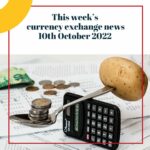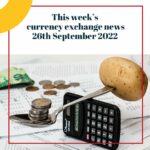This Weeks Currency News – How has the G7 meeting affected rates?
- Posted by Mathew in Uncategorized
- No Comments

Good Morning
Currencies continued to trade in the familiar tight ranges for most of last week as the markets awaited the US Consumer Price Index (CPI) for May, which, when published, reported the highest core inflation figure for 30 years. Investors remain concerned with the inflationary pressures that appear to be growing as the developed world recovers from the pandemic and how quickly central banks will stifle uptick by tightening policy. Initially, the dollar rallied before falling back and then rallying again into the close on Friday as the US Bond market belatedly reacted to the CPI data and yields increased. The pound was buffeted by these outside influences and has opened this morning a little easier than last week at $1.4100.
Another potentially busy week lies ahead with key data from the UK and the monthly Federal Reserve Open Market Committee (FOMC) meeting. After last week’s surprisingly high inflation report from the US, pressure has increased on the Federal Reserve to tighten policy. The markets will hang onto every word Jerome Powell says at the press conference following the meeting for any hints to a change in policy. There is an avalanche of reports from the Office for National Statistics (ONS) over the next few days for the pound to digest in the UK. In the background, as so often, there is an ongoing Brexit dispute with the EU rumbling on. The so-called “sausage wars “seem likely to continue into this week as the tricky issues of the Northern Ireland Protocol remained unresolved. Hopefully, the Euro 2020 tournament will be less contentious!
Click here to register and get live rates
UK
The pound had a relatively quiet week last week but may become more vulnerable this week as the final easing of restrictions on the 21st June looks likely to be delayed and tensions between the EU and the UK show little sign of easing. However, as has often been seen, the EU likes to take negotiations to the last minute. So far, the impact of the dispute over the Northern Ireland Protocol has been muted, with sterling virtually unchanged against the euro in the last week at €1.1650. We have a data-packed week in front of us starting tomorrow morning when the ONS will release Average Earnings and hopefully Employment figures that are continuing to improve. On Wednesday, it’s the UK’s turn for CPI, which is likely to show a rise towards the 2% level whilst not rising as quickly as the US. The week closes out with May’s Retail Sales which several analysts expect to disappoint after April’s sharp rise. We will be listening to Bank of England Governor Andrew Bailey when he speaks tomorrow afternoon for any comments on the morning’s unemployment data.
Euro
As expected, at their monthly meeting last week, the European Central Bank played down any chances of tightening policy soon. Whilst not unexpected, the market turned against the euro, and some quite heavy selling occurred, which pushed the single currency to below $1.2100 against the dollar. It remained against sterling, but both currencies remain vulnerable to any breakdown in the ongoing talks over the trade issues surrounding Northern Ireland. An extremely quiet week appears to lay ahead with mainly second-string data on the docket apart from Eurozone Industrial Production this morning, German CPI tomorrow, and lastly, May’s CPI for the Eurozone on Thursday.
US
The highlight of the week for financial markets, generally not least the currency markets, will be Wednesday’s FOMC meeting. However, with the markets entering summer mode and volatility decreasing, it is unlikely that the Fed will want to rock the boat by discussing tapering; indeed, it is most likely that Jerome Powell will do all he can to avoid the subject at the press conference. Only two reports stand out on the data docket: May’s Retail Sales and Industrial Production, both of which are released tomorrow. The retail sales data may unsettle the markets as they are likely to be distorted by disruptions to the car market caused by the shortage of semiconductors. Away from financial data, President Biden will continue his travels this side of the Atlantic with what should be interesting meetings with President Putin from Russia and his Turkish counterpart President Erdogan.Scandi
Scandi
Even though macro-data came in worse than expected last week, the Swedish krona kept on strengthening confirming what many analysts had written earlier about its seasonal performance. We are now in official krona strong ground that usually lasts until Midsummer and sometimes until the last Riksbank meeting in July which is the last one until the long summer holiday ending in mid-August. This week sees no major data releases which means technical and seasonal traders may outnumber day traders looking for quick profits.
The macro data from Norway also provided some sombre readings last week, in particular the latest CPI figure which was much lower than expected. It prompted the financial press to seriously question whether a rate hike from Norges Bank Governor Olsen will come in September, some going as far as saying that the Norwegian krone now has become a two-way bet. Volatility against most G10 crosses is expected to remain high throughout the week until the Deposit Rate announcement on Thursday. The market expects Governor Olsen to stay put but will closely listen to what he has to say regarding last week’s low inflation figures during the press conference.
Dont forget if you wan to secure a rate now or want more information just let us know by clicking here
Image courtesy of BBC





